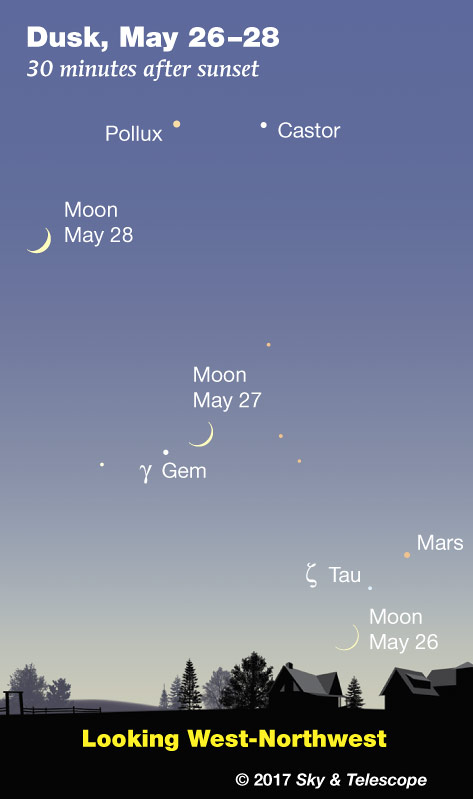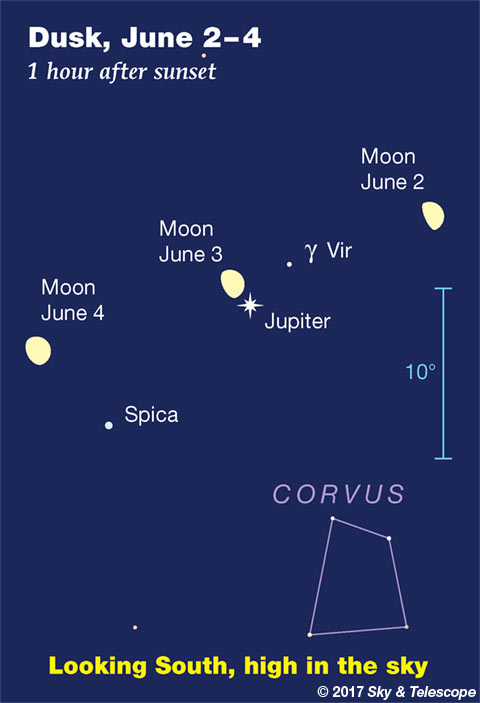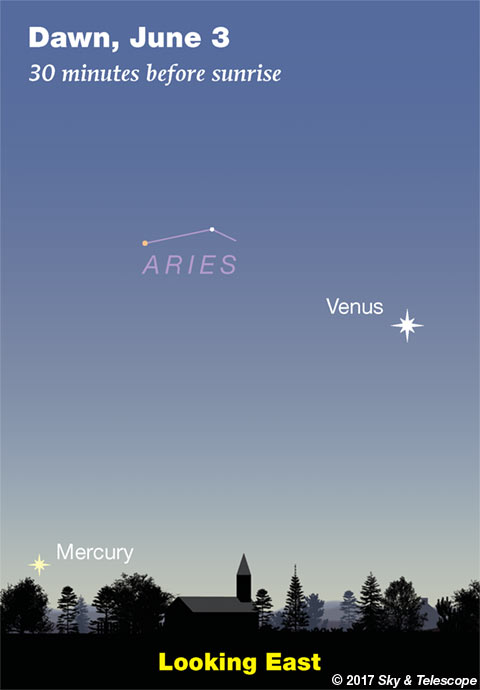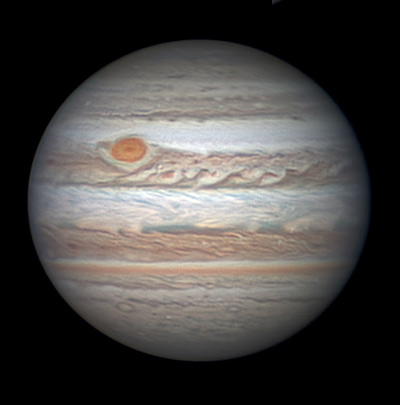
Friday, May 26
• While twilight is still bright, can you catch the thin crescent Moon just above the west-northwest horizon? The Moon is only about 1¼ days old as seen at the time of dusk for North America (because new Moon was at 3:44 p.m. EDT yesterday the 25th). And, how about little Mars to its upper right?
Saturday, May 27
• The thickening crescent Moon, now below the heads of the Gemini twins, shines near Gamma Geminorum (Alhena), the brightest star in the twins' feet.
Meanwhile, far to the Moon's lower right, Mars is passing between the horn-tips of Taurus (Beta and Zeta Tauri, magnitudes 1.6 and 3.0). The three form a diagonal line 8° long from upper right to lower left. Bring binoculars.
Sunday, May 28
• Arcturus shines 30° to the upper left of Jupiter after dusk. The brightest star very far to the lower left in the northeast is Vega. Look a third of the way from Arcturus to Vega for the delicate semicircle of Corona Borealis, the Northern Crown, with its brighter gem star Alphecca.
Two thirds of the way from Arcturus to Vega is the dim Keystone of Hercules.
Monday, May 29
• As soon as the sky is fully dark, but before the crescent Moon gets any lower in the west, take a look at it with binoculars or a wide-field scope — and then scan 3° or 4° to its upper right (as seen from North America). There you'll find the Beehive star cluster, M44, somewhat larger than the Moon.
Tuesday, May 30
• "Cassiopeia" usually means "Cold!" Late fall and winter are when this landmark constellation stands high overhead (seen from mid-northern latitudes). But even in late spring's warm evenings, it still lurks in view low. As twilight fades out, look for it down near the north horizon: a wide, upright W. The farther north you are the higher it'll appear, but even as far south as San Diego and Atlanta it's completely above the horizon.
Wednesday, May 31
• As the stars come out, look a few degrees to the right of the Moon to pick up Regulus. Once it's dark, you'll see that the Moon is under the belly of stick-figure Leo. He's walking down toward the lower right.
• Late tonight, telescope users in most of the U.S. and Canada can watch the dark limb of the Moon occult Rho Leonis, magnitude 3.8. Here's a timetable for hundreds of cities and towns. (The first third of the table gives disappearance times; the second third, reappearance times of the star on the Moon's bright limb, much harder to observe.)
The star is binary, magnitudes 4.3 and 5.4. But with its separation of only 0.1 arcsecond, the two steps of the occultation will happen only about a fifth of a second apart or less at most locations — pretty hard to distinguish.
Thursday, June 1
• First-quarter Moon (exact at 8:42 a.m. EDT). The Moon is now under Leo's tail star, Denebola.

Friday, June 2
• The Moon, Jupiter, and Spica form a gently curving arc this evening, as shown at right.
• Constellations seem to twist around fast when they pass your zenith — if you're comparing them to the direction "down." Just a week and a half ago, the Big Dipper was floating horizontally in late twilight an hour after sunset (as seen from 40° N latitude). Now it's angled diagonally at that time. Another week and a half and it will be hanging straight down by its handle!
Saturday, June 3
• Jupiter is the bright "star" with the Moon, as seen at right. They're only a couple degrees apart as seen at dusk from North America. But Jupiter is actually 1,860 times farther away (this evening).
• Lower left of Jupiter is Spica. Much closer to Jupiter in the opposite direction from Spica is fainter Gamma Virginis (Porrima), a close double star for telescopes: separation 2.6 arcseconds this year.
• And a double shadow-transit occurs on Jupiter tonight. From 10:22 p.m. to 12:22 a.m. EDT, both Io and larger Ganymede are casting their tiny black shadows onto Jupiter's face.
• And then Jupiter's Great Red Spot transits the planet's central meridian around 12:55 a.m. EDT (9:55 p.m. PDT). Quite a telescopic night for this group of objects.
________________________
Want to become a better astronomer? Learn your way around the constellations! They're the key to locating everything fainter and deeper to hunt with binoculars or a telescope.
This is an outdoor nature hobby. For an easy-to-use constellation guide covering the whole evening sky, use the big monthly map in the center of each issue of Sky & Telescope, the essential guide to astronomy.

Once you get a telescope, to put it to good use you'll need a detailed, large-scale sky atlas (set of charts). The basic standard is the Pocket Sky Atlas (in either the original or Jumbo Edition), which shows stars to magnitude 7.6.
Next up is the larger and deeper Sky Atlas 2000.0, plotting stars to magnitude 8.5; nearly three times as many. The next up, once you know your way around, is the even larger Uranometria 2000.0 (stars to magnitude 9.75). And read how to use sky charts with a telescope.
You'll also want a good deep-sky guidebook, such as Sue French's Deep-Sky Wonders collection (which includes its own charts), Sky Atlas 2000.0 Companion by Strong and Sinnott, or the bigger Night Sky Observer's Guide by Kepple and Sanner.
Can a computerized telescope replace charts? Not for beginners, I don't think, and not on mounts and tripods that are less than top-quality mechanically (meaning heavy and expensive). And as Terence Dickinson and Alan Dyer say in their Backyard Astronomer's Guide, "A full appreciation of the universe cannot come without developing the skills to find things in the sky and understanding how the sky works. This knowledge comes only by spending time under the stars with star maps in hand."
This Week's Planet Roundup


Mercury (about magnitude –0.2) is very deep in the glow of sunrise. Look for it about 25° lower left of Venus, as shown here. If you spot Mercury, you've succeeded in seeing it during its poorest apparition of the year.
Venus (magnitude –4.5) shines in the east during dawn. A telescope shows it just about at dichotomy (half-lit phase).
Mars (magnitude +1.7) is disappearing into the sunset. About 45 minutes after sunset, look for it just above the west-northwest horizon, 22° (two fists at arm's length) lower left of Capella.
Jupiter (magnitude –2.3, in Virgo) glares high and bright in the southern sky during evening. No other point in the evening sky is nearly that bright. Spica, noticeably bluer, glitters 11° lower left of it. In a telescope, Jupiter is shrinking as Earth pulls ahead of it in our faster orbit around the Sun. It appears 41 arcseconds wide this week.
Saturn (magnitude +0.1, at the Ophiuchus-Sagittarius border) rises in late twilight, glows after dark as the brightest point low in the southeast, and passes highest in the south around 2 a.m. Redder Antares (magnitude +1.0) twinkles 17° more or less to its right. Saturn will reach opposition on the night of June 14th.
Uranus (magnitude 5.9, in Pisces) is still hidden in the glow of dawn.
Neptune (magnitude 7.9, in Aquarius) is low in the east-southeast before the first light of dawn.
__________________________
All descriptions that relate to your horizon — including the words up, down, right, and left — are written for the world's mid-northern latitudes. Descriptions that also depend on longitude (mainly Moon positions) are for North America.
Eastern Daylight Time (EDT) is Universal Time (UT, UTC, or GMT) minus 4 hours.
__________________________
"This adventure is made possible by generations of searchers strictly adhering to a simple set of rules. Test ideas by experiments and observations. Build on those ideas that pass the test. Reject the ones that fail. Follow the evidence wherever it leads, and question everything. Accept these terms, and the cosmos is yours."
— Neil deGrasse Tyson, 2014
"Objective reality exists. Facts are often determinable. Vaccines do stop diseases. Carbon dioxide does warm the globe. Science and reason are no political conspiracy; they are how we discover reality. Civilization's survival depends on our ability, and willingness, to do so."
— Alan MacRobert, your Sky at a Glance editor
"Facts are stubborn things; and whatever may be our wishes, our inclinations, or the dictates of our passions, they cannot alter the state of facts and evidence."
— John Adams, 1770
 0
0








Comments
You must be logged in to post a comment.